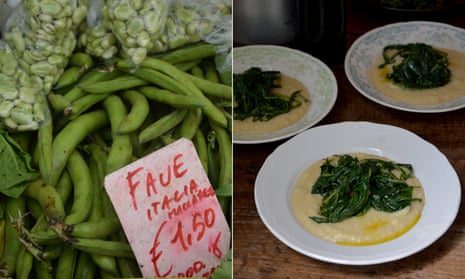At this time of year in Rome, broad beans act like cheerleaders chanting “S-P-R-I-N-G” from plates and piles in shops. They also come with a warning. This warning usually takes the form of a note stuck to the door of a shop or trattoria saying something along the lines of “Qui si vendono fave fresche” (“Here we sell fresh broad beans”). As warnings go, it’s mild stuff. In fact, for years not only did I have no idea that these notes were warnings, I also thought they were a promotion – a handwritten invitation to come inside and be rewarded with beans waiting to be freed from their velour-lined jackets and eaten with pecorino, braised with artichokes or caught up in a tangle of pasta and cheese.
The notes are far from mild for some. Favism is an ancient hereditary disorder that affects people of Mediterranean descent. It’s rare but dangerous, and involves an allergic-like reaction to broad beans. “One of our customers can’t even walk past our door when fava are in season,” a local trattoria owner told me, flicking beans out of their pods directly into a pan like some sort of vegetable Tiddlywinks. I spent the next few days worrying about this customer, noting all the streets they couldn’t walk down (most of them). While the dangerous compound is largely deactivated by cooking, with all the cheerleaders around at this time of year, it would be best to avoid certain streets.
For those of us who aren’t avoiding broad beans, as the month progresses, both the pods and their beans get bigger, the sugar turning to starch and transforming tender, early-spring beans floury and almost white. As in beans, so in life. They also start to dry, which is no bad thing. As this happens, cooking methods must change. No more swift, steamy braises; the opaque coats need pulling off, and the bigger beans should be cooked more slowly, braised in tomato sauce or made into a puree. This is known in Rome as purèe di fave, in Puglia as simply fave (e cicoria), and in Sicily as maccu.
Just like the pork last week, maccu or puree di fave is a recipe that sums up the neat brilliance of Italian cooking: three economical ingredients transformed into a clever dish. There are as many recipes for maccu as cooks. I prefer maccu soft – closer to a thick soup than a hummus. That said, the cooked puree set cold makes an excellent spread for bread or a dip for crisp vegetables.
Although this is delicious made with end-of-season fresh beans, I think maccu is even better made with fully dried broad beans, fave secche, which seem like cannellini crossed with chestnuts, chickpeas and something ever so slightly bitter, but tempered by the potato.
For the greens on top, dark, saw-edged cicoria or chicory is traditional. If you can’t get hold of cicoria, spinach, escarole or even radicchio would work well. Either way, pile the leaves on top of the soft puree, the cheerleaders getting older with the right amount of bitterness.
Maccu di fave e cicoria (broad bean puree with greens)
Prep 15 min
Soak 2 hr
Cook 1 hr
Serves 4
250g dried broad beans or 400g fresh but starchy broad beans, outer coats removed
2 medium potatoes, peeled and sliced into rounds
Salt
800g greens (chicory, escarole, spinach or radicchio)
1 pinch red chilli flakes
Olive oil
2 garlic cloves, peeled and squashed
If you’re using dried beans and have the time, soak them in cold water for a few hours (if you don’t have time, don’t worry, they will just take longer to cook).
Put the beans in a large pan, cover with a layer of potato, then pour over a litre of water. Bring to a boil, then reduce to a simmer for 25 minutes to an hour, stirring every now and then. By the end of cooking you should have a soft cream. For something even smoother, blend with an immersion blender. Season with salt.
If you are using cicoria, trim, then plunge into boiling water for four minutes, and drain. In a large frying pan, heat a drizzle of olive and the garlic. Add the cicoria and a pinch of red chilli flakes, and stir until the greens glisten.
If you’re using escarole, spinach or radicchio, break into leaves. In a large frying pan, heat a drizzle of olive with the garlic. Add the leaves and a pinch of red chilli flakes, and stir until the leaves collapse and glisten. Serve the puree in bowls, topped with the greens and a drizzle of olive oil.

Comments (…)
Sign in or create your Guardian account to join the discussion